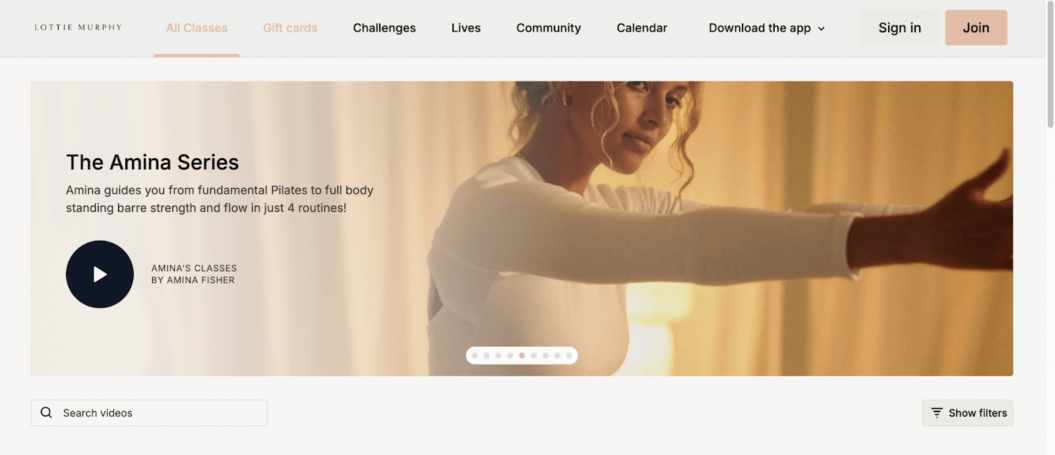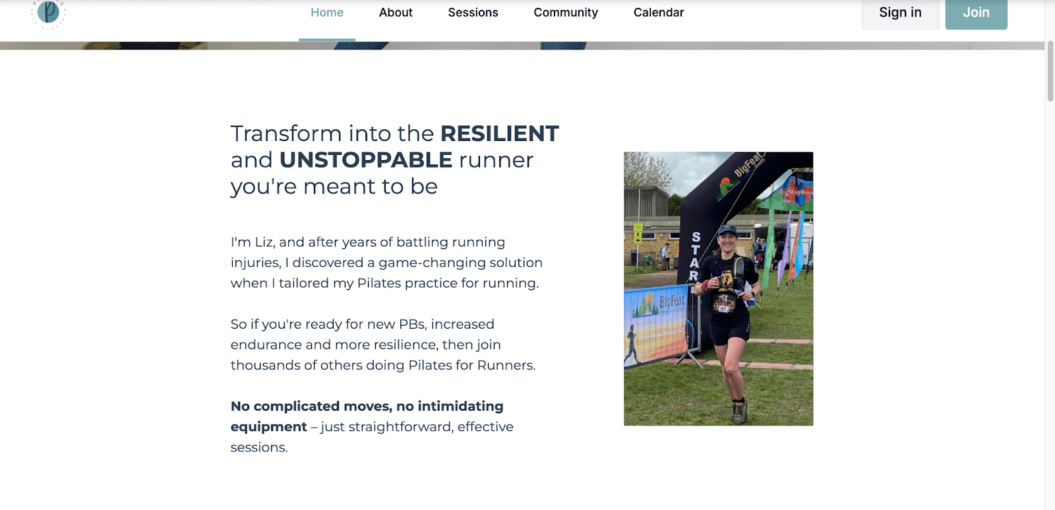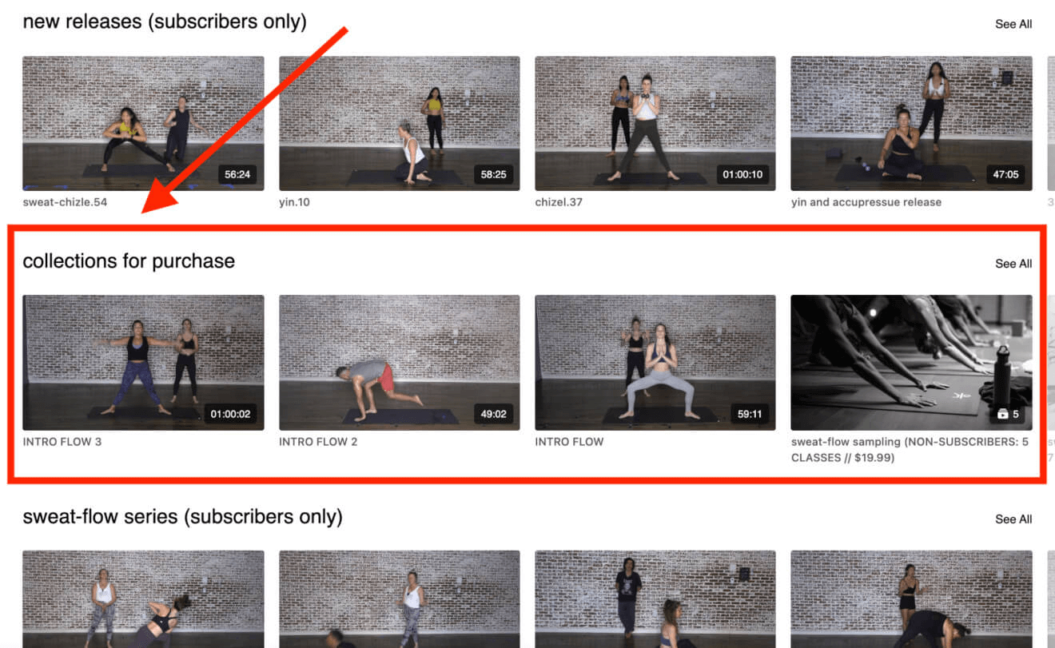Being a pilates instructor can be unpredictable
You teach control and stability, but behind the scenes, finding consistent income can feel anything but stable or under control.
You didn’t become a Pilates instructor just for the money, but doesn’t it feel like it used to be easier to make a living?
Here’s the good news…
The online Pilates industry is booming, and demand for at-home workouts is higher than ever. While YouTube and social media help grow your audience, they don’t provide reliable income.
The best way to teach Pilates online—and build stable, recurring revenue—is to launch an online Pilates Studio on your own independent membership platform.
Here’s how to do it.
Why You Should Offer Online Pilates Classes
Pilates has developed an incredible online community.
You may have already seen this with the rise of pilates instruction on Instagram and YouTube. Instructors like Lottie Murphy, founder of Lottie Murphy Pilates, have reached millions of people through online Pilates workouts.

So why are they so popular?
It’s for two reasons:
- Students can train with their favorite Pilates instructors on their own schedule.
- Instructors can connect with a global audience and build a thriving online community.
Taking your Pilates classes online allows you to build a Pilates business without the limitations of in-person teaching. It puts you in control, giving you the freedom to focus on helping your students—without being tied to a single studio.
Better still…
Pilates instructors who transition to teaching online earn an average of $7,500 a month, and that number continues to grow.
When you establish your own independent platform, you unlock even more benefits:
- Bring together a global community – Guide an entire community toward better strength, stability, and mobility.
- Gain location independence – Teach classes, create workouts, and connect with your audience from anywhere.
- Generate passive income – Earn money while you sleep, work out, and enjoy your day.
- Help an endless number of people – There’s no cap on how many students you can reach with your Pilates expertise.
- Monetize social media – Turn the videos and workouts you already create into a profitable business.
But what exactly does it mean to “teach Pilates online?”
I’m glad you asked.
Simple: you launch your own online Pilates studio.
Let’s take a closer look at what that is.
What Is an Online Pilates Studio (and Why You Should Start One)?
An online Pilates studio is a membership-based platform (website and apps) where you offer premium Pilates workouts and programs to your students for a recurring fee.
Simply put:
You create a video streaming service that functions as your online studio—a central hub where students can access all your Pilates workouts, tutorials, and structured programs.
With your own online Pilates studio, you can:
- Offer structured, easy-to-follow workout programs.
- Build a strong online Pilates community.
- Connect directly with your students and keep them engaged.
Because the world operates online, this model scales infinitely. You’re no longer limited by studio class sizes or local demand—you can train and motivate students from anywhere in the world.
For example, Lottie Murphy built a thriving online Pilates business by offering a mix of on-demand classes, structured programs, and community-driven content:

Since launching her membership, she has grown a community of thousands of paying members who can train with her anytime, anywhere.
A traditional Pilates studio simply can’t match that level of accessibility and scale.
Plus, instructors who build their own platform can further monetize by offering personalized coaching, advanced workshops, or instructor training programs on top of their membership content.
It’s safe to say that teaching Pilates online is one of the most profitable ways to grow, help, and inspire your community.
Let’s take a look at how you can launch your own online Pilates studio.
How to Teach Pilates Online in 5 Simple Steps
In this section, I’ll guide you through the five steps to launching your own online Pilates studio:
- Decide the Niche You Want to Teach In.
- Create a Few Videos to Discover Your Style.
- Create an Online Pilates Studio Website.
- Pick a Business Model and Set Your Prices.
- Create a User Funnel to Build Your Community.
By following these steps, you’ll be able to build a thriving online Pilates business that attracts and retains members.
1. Decide the Niche You Want to Teach In
You’re a Pilates instructor with countless hours of teaching and practice under your belt. So, you likely already have a sense of what resonates with your community and what they’re looking for in a workout.
When moving your business online, it’s important to define a clear niche—an area of expertise that sets you apart from other Pilates instructors.
So, what makes your Pilates method unique?
- Do you focus on core strength and functional movement for everyday life?
- Do you help new moms regain strength through postnatal Pilates?
- Do you specialize in low-impact Pilates for injury recovery?
- Do you offer athletic Pilates to enhance sports performance?
- Do you teach short, effective routines for busy professionals?
- Do you want to help beginners master the foundations of Pilates?
There’s no wrong answer—the right niche is what reflects your expertise and passion.
Take Liz Patient’s Pilates for Runners, for example. She built this online pilates studio specifically for runners looking to improve strength, flexibility, and injury prevention through Pilates. By targeting a specific audience with clear needs, it has created a highly engaged community and a successful business model on Uscreen.

Take time to define what you want to teach and how it will benefit your Pilates community.
For inspiration, check out these successful online Pilates platforms:
- Lottie Murphy Pilates – A holistic approach to Pilates and mindful movement.
- Fit with Coco – Short, effective Pilates workouts designed for everyday life.
- Range by Kara Duval – Strength-focused, functional Pilates routines.
Each of these has a distinct approach that makes them unique—and you can do the same for your online Pilates studio.
2. Create a Few Videos to Discover Your Style
Once you know what you’re going to teach, it’s time to experiment.
You should dedicate some time to trying out different ways of teaching on camera and find a style that feels comfortable for you.
There are three styles I suggest you try:
The first is studio presentation. This is where you instruct from your mat, just as you would in a group class.
You can set this recorded class up quite easily, and it’s a viewpoint your subscribers will be familiar with. It’s especially useful if you have limited equipment, since it’s just you and your camera.
The second is class instruction. This is where you record your live studio classes and use them on your site.
This style is particularly useful if you plan to live stream Pilates workouts. However, it can feel less personal, since students are watching an existing class rather than being directly engaged. It’s a great supplementary format, but use it sparingly!
The third is follow-along instruction. This is where you perform the exercises while providing instruction through voice-over narration:
This method has become a go-to format for online Pilates instructors because it allows you to demonstrate proper form without having to multitask by talking and moving at the same time. It’s an effective strategy but requires more editing to sync your guidance with the workout.
Any of these styles can resonate with your audience. If you already have a style that works, stick with it. If you’re still figuring out what’s best, it’s a good idea to create several videos in different styles and test your audience’s reactions.
Your on-camera presence contributes to the success of your training videos, too. Potential students look for a coach who demonstrates the strength, control, and results they want to achieve through Pilates. Maintain a confident and engaging teaching style, and prioritize your own self-care, rest, and well-being so you bring your best energy to every session.
Here’s our resident fitness expert, Dan, on all the techniques you need to film the highest quality workout videos:
3. Create an Online Pilates Studio Website
Your video streaming website is the storefront for your membership program. It’s where potential students will go to learn more about your Pilates workouts, check your pricing, and decide if your teaching style is right for them.
It’s important to have a professional-looking website to grow your online presence and attract the right audience—but don’t worry, you don’t need to be a web designer to make it happen!
Uscreen gives you the tools to make this process simple. Our drag-and-drop page builder allows you to customize your online Pilates studio without any coding knowledge, giving you complete control over how your platform looks and feels.
Take a look at these Pilates and fitness video streaming websites (all built using Uscreen) to see what’s possible:
You can also browse more Uscreen examples here.
Why Branding Matters
Branding plays a major role in how your website looks and the type of community members you attract. Your colors, logo, and messaging should reflect your Pilates philosophy—whether that’s athletic, rehabilitative, beginner-friendly, or something else.
This topic goes beyond the scope of this article, so we’ve broken down the key elements of a strong fitness brand here.
These insights apply across the entire digital fitness space, including Pilates.
Once your website is built, it’s time to set your prices.
4. Pick a Business Model and Set Your Prices
Pilates instructors often struggle with pricing their services online. It can be challenging to translate what you charge in a studio to an online membership model.
Let’s start by looking at the two conventional ways you can sell your Pilates videos:
TVOD – Transactional Video On Demand
TVOD is where students pay for individual videos or courses. You can either:
- Sell them lifetime access to a specific workout or program.
- Offer a rental option, where access is granted for a limited period.

This model can work well for selling one-off Pilates courses, such as:
- A comprehensive beginner’s guide to foundational Pilates techniques.
- A specialized athletic Pilates program with downloadable resources.
The benefit of this model is that you can charge a higher price per purchase. The drawback is that it doesn’t provide recurring revenue, so you’ll need to market and sell new content constantly.
SVOD – Subscription Video On Demand
A subscription model (SVOD) is the best pricing strategy for building a strong, community-driven Pilates membership.
With SVOD, your customers pay a monthly or annual fee for unlimited access to your workouts. As long as they keep their membership active, they can log in anytime and train at their own pace.

Pilates membership pricing examples:
- $15/month for a standard subscription.
- $150/year for an annual subscription (often marketed as “2 months free”).
Offering a discount on annual memberships is a great way to increase retention and guarantee long-term members.
Although the monthly fee is lower than a one-time course, recurring revenue compounds over time, making your business more sustainable and profitable.
I recommend starting with these price points and adjusting as needed. If you’re unsure, start on the lower end and raise your prices as your community grows. If you’re confident in your content’s value, don’t be afraid to charge more!
5. Create a User Funnel to Build Your Community
Your user funnel is a system that consistently brings new people into your Pilates community.
Once it’s up and running, it will give you peace of mind—knowing that a steady stream of potential subscribers is discovering your content, visiting your site, and signing up for your membership.
At a basic level, your user funnel follows this four-step process:
Discover your brand → Visit your site → Trial your product → Become a paying subscriber
Based on our research into successful online Pilates instructors, this 4-step approach has been the most effective:
- Generate buzz – Use promotional strategies (like Instagram Reels, podcast appearances, YouTube shorts, and email newsletters) to share your content and brand. Engaging with Pilates Facebook groups or fitness communities can also drive awareness.
- Refer them to your site – Create a strong message and clear call to action that brings potential members to your website.
- Offer a free trial – Give people 7 to 14 days to explore your Pilates membership at no charge, so they can experience the value firsthand.
- Follow up with those who don’t convert – Send a gentle follow-up message to people who cancel their free trial or let their membership lapse, offering an incentive to return.
You can find more details on each step of this process in the links above.
However, if you’re looking to build a strong marketing system that keeps your business growing, check out our guide on how to create a “marketing engine” right here.
It will show you everything you need to attract, convert, and retain your ideal Pilates students!
Okay, Now You Can Relax…
Phew! That was a lot to work through, right?
By now, you can see the limitless potential of teaching Pilates online. Moving beyond the brick-and-mortar studio and into the digital space allows you to:
- Teach Pilates your way, with full creative control.
- Reach a global audience and build a loyal community.
- Grow a sustainable, profitable Pilates business.
- Become location-independent, teaching from anywhere.
- Earn an average of $7,500 a month.
To launch your own online Pilates studio, follow these five key steps:
- Define your niche.
To build a successful online Pilates business, you need a clear area of expertise that sets you apart from the competition. - Discover your unique teaching style.
Once you’ve identified your niche and target audience, experiment with different video styles to find what works best for you. - Build your Pilates studio’s website.
Your video membership site is the home base of your online Pilates program. A well-designed website will help you attract the right audience and grow your brand. - Set your prices.
Pricing Pilates memberships can feel tricky at first. The three most common monetization models are subscription-based and transactional (one-time payment), but SVOD (subscription-based) is the most reliable for growth. - Create a user funnel to grow your community.
Your user funnel ensures a steady flow of new members by bringing potential subscribers to your site, engaging them, and converting them into paying customers.
And if you need help along the way, Uscreen is always here to support you in launching and growing your online Pilates business!
Build, launch and manage your membership, all in one place.






